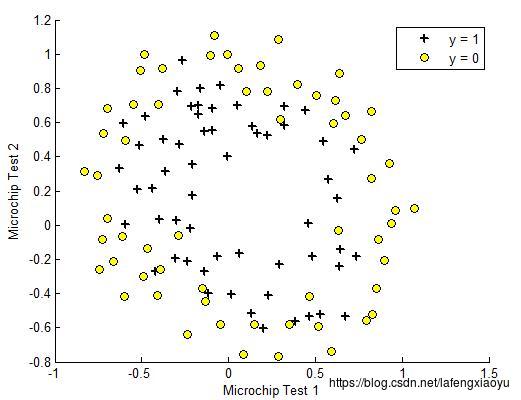机器学习2 逻辑回归(Logistic Regression)
Posted 拉风小宇
tags:
篇首语:本文由小常识网(cha138.com)小编为大家整理,主要介绍了机器学习2 逻辑回归(Logistic Regression)相关的知识,希望对你有一定的参考价值。
逻辑回归
首先谈一下我对这部分知识的理解,逻辑回归(西瓜书叫做对数几率回归)在这一部分主要是用于做分类的。
我们以一次考试为例,考试分为两门课,一共一百位同学参加考试,用黑色“+”表示通过,黄色“o”表示未通过,在二维坐标轴中将其表示出来

这是一个二分类问题,对于二分类来讲,最理想的就是“单位阶跃函数”了,
y
(
z
)
y(z)
y(z)在
z
>
0
z>0
z>0的时候为1,在
z
<
0
z<0
z<0时为0,在
z
=
0
z=0
z=0时是0.5。但是单位阶跃函数的问题是他不连续,因此我们找到对数几率函数(logistic function)作为其替代函数,其在0附近有很大的变化率。我们可以认为在“大于0时为1,小于0时为0”,这样做二分类的效果是不错的。

sigmoid函数
在计算代价函数之前,首先回忆logistic回归假设由下式定义:
h
θ
(
x
)
=
g
(
θ
T
x
)
,
h_\\theta(x)=g(\\theta^Tx),
hθ(x)=g(θTx),
其中函数
g
g
g是sigmoid函数,其中sigmoid函数由下式定义:
g
(
z
)
=
1
1
+
e
−
z
g(z)=\\frac11+e^-z
g(z)=1+e−z1
MATLAB实现如下
function g = sigmoid(z)
%SIGMOID Compute sigmoid functoon
% J = SIGMOID(z) computes the sigmoid of z.
% You need to return the following variables correctly
g = zeros(size(z));
% ====================== YOUR CODE HERE ======================
% Instructions: Compute the sigmoid of each value of z (z can be a matrix,
% vector or scalar).
%g = (1/(1+exp(-z)));
for i=drange(1:size(z,1))
for j=drange(1:size(z,2))
g(i,j)=((1/(1+exp(-z(i,j)))));
end
end
% =============================================================
end
代价函数和梯度
logistic回归中的代价函数为下式
J
(
θ
)
=
1
m
∑
i
=
1
m
[
−
y
(
i
)
log
(
h
θ
(
x
(
i
)
)
)
−
(
1
−
y
(
i
)
)
log
(
1
−
h
θ
(
x
(
i
)
)
)
]
J(\\theta)=\\frac1m\\sum_i=1^m[-y^(i)\\log(h_\\theta(x^(i)))-(1-y^(i))\\log(1-h_\\theta(x^(i)))]
J(θ)=m1i=1∑m[−y(i)log(hθ(x(i)))−(1−y(i))log(1−hθ(x(i)))]
并且代价函数的梯度是与
θ
\\theta
θ长度相同的向量,其中第
j
j
j个元素由下面的式子进行定义:
∂
J
(
θ
)
∂
θ
j
=
1
m
∑
i
=
1
m
(
h
θ
(
x
(
i
)
)
−
y
(
i
)
)
x
j
(
i
)
\\frac\\partial J(\\theta)\\partial \\theta_j=\\frac1m\\sum_i=1^m(h_\\theta(x^(i))-y^(i))x_j^(i)
∂θj∂J(θ)=m1i=1∑m(hθ(x(i))−y(i))xj(i)
这个公式看起来和线性回归的梯度公式是一样的,但是事实上却不同,因为线性回归和logistic回归对于
h
θ
(
x
)
h_\\theta(x)
hθ(x)是有不同的定义的。因此不能够用LMS的方法求解,但是可以用随机梯度下降的方法进行求解,代价函数和梯度计算的MATLAB程序如下
function [J, grad] = costFunction(theta, X, y)
%COSTFUNCTION Compute cost and gradient for logistic regression
% J = COSTFUNCTION(theta, X, y) computes the cost of using theta as the
% parameter for logistic regression and the gradient of the cost
% w.r.t. to the parameters.
% Initialize some useful values
m = length(y); % number of training examples
% You need to return the following variables correctly
J = 0;
grad = zeros(size(theta));
% ====================== YOUR CODE HERE ======================
% Instructions: Compute the cost of a particular choice of theta.
% You should set J to the cost.
% Compute the partial derivatives and set grad to the partial
% derivatives of the cost w.r.t. each parameter in theta
%
% Note: grad should have the same dimensions as theta
%
my = y.*(-1);
oy = 1.-y;
h = X*theta;
first = (1/m)*(my.*log(sigmoid(h)));
sec = (1/m)*oy.*log(1-sigmoid(h));
J = sum(first-sec);
grad = (1/m)*(X'*(sigmoid(h)-y));
% =============================================================
end
同样的,我们需要求出代价函数的最小值从而求得 θ \\theta θ值。我们这里直接利用MATLAB给出的内置函数来求解
%% ============= Part 3: Optimizing using fminunc =============
% In this exercise, you will use a built-in function (fminunc) to find the
% optimal parameters theta.
% Set options for fminunc
options = optimset('GradObj', 'on', 'MaxIter', 400);
% Run fminunc to obtain the optimal theta
% This function will return theta and the cost
[theta, cost] = ...
fminunc(@(t)(costFunction(t, X, y)), initial_theta, options);
% Print theta to screen
fprintf('Cost at theta found by fminunc: %f\\n', cost);
fprintf('theta: \\n');
fprintf(' %f \\n', theta);
得到 θ \\theta θ的值为
theta =
-24.9329
0.2044
0.1996
因此
θ
T
x
\\theta^Tx
θTx为
−
24.9329
+
0.2044
x
1
+
0.1996
x
2
=
0
-24.9329+0.2044x_1+0.1996x_2=0
−24.9329+0.2044x1+0.1996x2=0
在这条线的上方,大概率应该是通过了的,在下方则认为是没有通过的

可以通过代码或者肉眼也可以看出有89个点是落在应该落在的区域中,分类效果还是蛮好的。
正规化逻辑回归
这一部分的例子相对于上一部分更加复杂一些,假设你是一个元器件厂的经理,每一个元器件需要经过两个测试,然后用黄色圆点表示不合格产品,而用黑色“+”表示合格品。用下图表示

这个模型用刚才的方法显然就不合适了,需要进行特征映射
特征映射
我们这里提出的方案是将特征
x
1
x_1
x1和
x
2
x_2
x2映射入一个六次多项式
m
a
p
F
e
a
t
u
r
e
(
x
)
=
[
1
x
1
x
2
x
1
2
x
1
x
2
x
2
2
x
1
3
⋮
x
1
x
2
5
x
2
6
]
mapFeature(x)=\\left[ \\beginarrayc 1\\\\ x_1\\\\ x_2\\\\ x_1^2\\\\ x_1x_2\\\\ x_2^2\\\\ x_1^3\\\\ \\vdots\\\\ x_1x_2^5\\\\ x_2^6 %第一行元素 \\endarray \\right]
mapFeature(x)=⎣⎢⎢⎢⎢⎢⎢⎢⎢⎢⎢⎢⎢⎢⎢⎢⎡1x1x2x12x1x2x22x13⋮x1x25x26⎦⎥⎥⎥⎥⎥⎥⎥⎥⎥⎥⎥⎥⎥⎥⎥⎤
这就将二维特征的向量转换为28维的向量。在这个更高维度的特征向量上做logistic回归在二维中绘制将会有更复杂的边界。
映射函数如下
function out = mapFeature(X1, X2)
% MAPFEATURE Feature mapping function to polynomial features
%
% MAPFEATURE(X1, X2) maps the two input features
% to quadratic features used in the regularization exercise.
%
% Returns a new feature array with more features, comprising of
% X1, X2, X1.^2, X2.^2, X1*X2, X1*X2.^2, etc..
%
% Inputs X1, X2 must be the same size
%
degree = 6;
out = ones(size(X1(:,1)));
for i = 1:degree
for j = 0:i
out(:, end+1) = (X1.^(i-j)).*(X2.^j);
end
end
end
当然值得一提的是,过拟合的现象是会因为维度提高发生的,因此我们需要想办法去克服。
代价函数和梯度
在正规化的logistic回归中的代价函数是 以上是关于机器学习2 逻辑回归(Logistic Regression)的主要内容,如果未能解决你的问题,请参考以下文章
J
(
θ
)
=
1
m
∑
i
=
1
m
[
−
y
(